The Ukrainian Conflict: A Ukrainian Nationalist View, Part 1

Editor’s note: This series of articles on the current upheavals in Ukraine is written from the perspective of a Ukrainian nationalist. It also provides a nationalist perspective on Ukrainian history leading up to the present. It is of interest to TOO readers for many reasons. In particular, there are detailed comments on the conflict with Russia — a textbook case of competing nationalisms as described by Tom Sunic in several places (e.g., “Which way White Man?”).
Comments are open for this article.
Over the past few months, there has been an enormous amount of analysis done in Western nationalist circles on the conflict in Ukraine. This analysis was, quite naturally, originally focused on the protests against the now overthrown Yanukovych government — and has since transferred towards the conflict between Ukraine and anti-state protesters inside the country. The events have been analyzed from an array of different perspectives: everyone from Eurasianists (or perhaps, I should call them “Duginists”) to Third Positionists and everything in between.
Although each respective analysis has come from a different angle, virtually every single piece of information on Ukraine on Western nationalist websites shares one key trait: a complete lack of anything even remotely close to the Ukrainian nationalist view. This complete lack of presence of the Ukrainian nationalist view has given rise to numerous myths and quite strange theories. It can be compared to a modern, informational Iron Curtain. Western nationalists and Ukrainian nationalists currently live in separate universes in terms of their information, and this has lead to numerous, unfortunate misunderstandings. In this article, I hope to finally give the Ukrainian nationalist view.
There are many topics to cover, and I will try to go over each of them as briefly as possible. The article is divided into three sections: myths regarding Ukraine, the overthrowing of the Yanukovych government, and the current conflict with the Russian Federation. I will most certainly be reading the comments and note any criticisms. So please, do not be shy. I do not ask you to believe only the Ukrainian nationalist view. I do ask you to remember that when taking any side in a conflict, one must know both sides of the argument itself. And at this moment, this is essentially impossible. Due to a widespread lack of informational presence of Ukrainian nationalists, only one side is known.
Part 1: Myths of Ukrainian History and Culture
Regardless of ideological school, every nationalist in the modern West is essentially a dissident in the classical sense of the word. Any person in the West who feels that Western peoples have the right to self-preservation risks being violently attacked, fired from work, or simply thrown into jail. As with many dissidents, the modern Western dissident looks for alternative information from sources that appear different from those of their oppressors.
This is normal and logical. Yet, when discussing Ukraine this is a problem. The vast majority of information regarding Ukraine obtained by Western nationalists ultimately stems from the Kremlin: whether it is the more mainstream Russia Today or the more rebellious Alexander Dugin. It is no wonder, then, that the myths spread regarding Ukrainians closely resemble former Soviet myths and tactics regarding us. I will attempt briefly to go over the largest propaganda myths spread against Ukraine and refute them. Please be aware that a separate article can be written on each one, and I am only trying to briefly summarize the most widespread ones as briefly as possible.
Myth 1: Ukrainians don’t exist
Perhaps the biggest one (and most anti-Ukrainian one) is that “Ukraine is a fake state,” “Ukraine was never a state,” “Ukrainians are not a nation,” etc. Essentially, this piece of propaganda claims that the Ukrainian state is not a legitimate idea — that it is a state that was essentially created out of nothing, and this is the cause of its political turmoil.
The myth becomes most insulting when it is claimed that the Communists created Ukrainians and/or Ukraine. This is the most insulting because it was actually the Communists that destroyed the first modern-day Ukrainian state: the Ukrainian Peoples Republic, which came into existence after the collapse of the Russian empire and was destroyed in 1920 after a war with the USSR.
The early 20th century in general was a chaotic one for Ukrainians. Two identical, geographically separate Ukrainian states arose with the goal of reuniting Ukrainians: the Ukrainian Peoples Republic (eastern central Ukraine, central Ukraine, and some of Western Ukraine, as well as some lands currently located inside Russia arising out of the Russian Empire), and the Western Ukrainian Peoples Republic (with the rest of modern Western Ukraine, arising out of the Polish Empire).
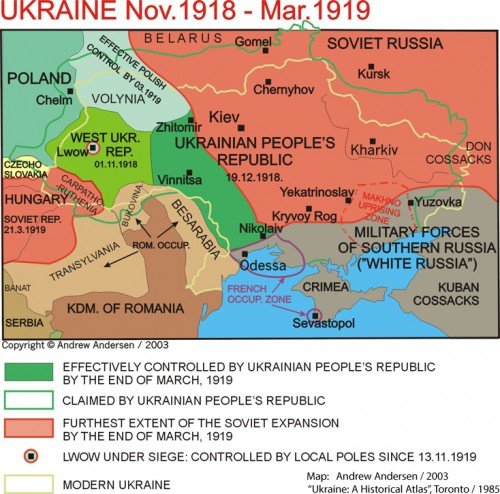
While at the time, unfortunately, foreign aggression did not allow them ultimately to reunite, the fact that they all proclaimed such a goal, all had the same national anthem, crests and spoke the same language clearly shows they all belonged to one people. These states were identical in terms of language, symbols, etc., and covered all — I repeat, all — of the territory of modern Ukraine. One can view them as similar to North and South Korea, or eastern and Western Germany: one people, different states.
Actually, this fact is something Ukrainians can take pride in: people who have lived separately, occupied by different empires for hundreds of years maintained the same language, viewed themselves as one people and given the slightest chance, immediately pushed for reunification with their brothers. Ukrainians in this sense have been exactly the same as Kurds — a people divided by foreign empires, a stateless people, but most certainly one, united people.
Far from being a “falsely created people.” Ukrainians view our nation as one of the oldest in Europe and Asia: our roots are in the ancient Trypillian civilization that laid the foundation of the Ukrainian nation and culture over 5000 years ago. Many unique practices in modern Ukrainian culture and even words date back specifically to this civilization (For further reading, see Ukraine: from Tripillya to the Antes [Kyiv, 2009]) and it has been proven that the majority of Ukrainians by DNA are directly descendants of different tribes of this civilization.
Since then, human life that existed on inhabited parts of modern Ukraine always shared the same collective conscience (the key trait of a nation), from Kyivian Rus to Cossack states: there was never a time since then when (by their own will; thus, not counting foreign occupation) separate entities were formed by Ukrainians that opposed each other — when completely separate worldviews and cultures existed amongst Ukrainians; there was always one genuine collective conscience in Ukraine for thousands of years that even transcended different imperial borders. This speaks of one, united ethnic people existing in Ukraine, and not “peoples brought together by Communists,” as propaganda from the Kremlin speaks of.
Of course, I do not wish to make it look like Ukrainians are some sort of special people. All peoples in Europe have a long history and their own national myths. I merely wish to reiterate that Ukrainians are by no means a “new people created by the Communists,” nor “Polanized Russians,” Ukrainians are a unique people who formed on all of the territory of modern Ukraine and were separated not by our own will, but by the will of foreign empires.
There is also significant proof that shows an enormous role modern Ukraine had in forming the White race — conducted largely by foreign researchers.
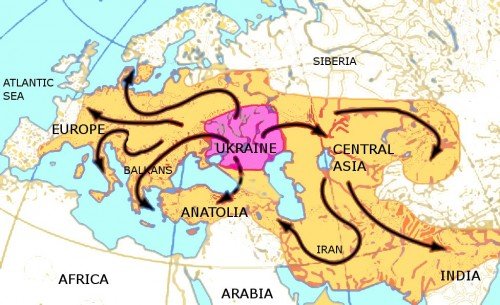
The Kurgan hypothesis of Indo-European origins and expansion
Below: Versions of the Tryzub in ancient Ukraine, the state-symbol of modern Ukraine

Versions of the Tryzub in ancient Ukraine, the state-symbol of modern Ukraine
Myth 2: Catholic vs Orthodox
This myth states that Western Ukraine is Catholic and eastern Ukraine is Orthodox. This myth states that Eastern Ukraine favours Russia because it is Orthodox, while Western Ukraine favours the West because it is Catholic.
In reality, the majority of Western Ukraine is Orthodox and Ukrainians as a people are almost 90% Orthodox. Catholicism in Western Ukraine exists in the form of Greek-Catholicism — which is the religion of 60% of three small regions (out of over a dozen regions overall) of Western Ukraine called Galicia. Yet, Greek-Catholics have an inherently Eastern, Byzantine identity, cemented by the fact that this religion is, essentially, Orthodox Christianity that recognizes the Pope; and reinforced after years of unfortunate conflict with Roman Catholic Poles. Greek-Catholicism in Ukraine came into existence in the 16th century when Orthodox Ukrainians controlled by Poland turned towards the Vatican and asked it to protect Ukrainian culture inside Poland. The Vatican agreed, as long as they recognized the Pope. Some refused, some accepted. While internal conflicts did exist in history (for instance, early the Ukrainian King and leader of the Ukrainian Cossacks Petro Sahaydachny, from Galicia (Western Ukraine) himself, re-took key religious shrines in Kyiv from Greek-Catholics later in history), they were few and far between and, quite clearly, conflicts within one nation.
Furthermore, especially during the 19th century, it was among the Ukrainian Greek-Catholic clergy — not Ukrainian Orthodox clergy — that so-called Moscowphile (pro-Moscow) tendencies arose, with numerous priests and bishops pledging allegiance to Moscow after conflicts with Poland and calling upon all Ukrainians to do so. It was the Ukrainian Orthodox who trusted Moscow less and Ukrainian Orthodox who were more nationalistic, especially at the beginning of the 20th century.
I can confidently say that amongst Ukrainians, virtually no religious tension exists. Throughout the world and in Ukraine, if there is no Orthodox Church, Ukrainian Orthodox people will always visit a Ukrainian Greek-Catholic Church and vice versa. This is because both of these religions are what we call Kyivian Christianity: they are a direct result of when King Volodomyr Christened Ukraine, and Ukrainians view both of them as “ours.” A Ukrainian Greek-Catholic views the Ukrainian Orthodox Church with more trust than the Roman Catholic Church; and a Ukrainian who is Orthodox views the Ukrainian Greek-Catholic Church with more trust than any other Orthodox Church. Ukrainian nationalists, both Greek-Catholic and Orthodox, always state that in terms of religion the goal is to re-unite the two Ukrainian Churches into one (Orthodox) Church. Thus, Catholic vs. Orthodox is not a reason for the division of Ukraine.
Myth 3: Ukrainian nationalists as Nazis
This myth states that Ukrainian nationalists are essentially all neo-Nazis. The government in Kyiv is apparently even Fascist, says Russia Today. This myth has gained ground for a few reasons: namely due to symbols used by us and and because of history.
Firstly, there exists a Ukrainian nationalist symbol that looks quite similar to a Wolfsangel. This symbol is actually called the Ідея Нації symbol, or the “Idea of the Nation” symbol. It was first used and resurrected by new-right organizations in Ukraine in the 1990s. The only movement that officially uses it as its symbol is the Patriot of Ukraine movement, yet currently it is essentially the unofficial symbol of the new-right in Ukraine, regardless of organization, used unofficially by everyone everywhere. It combines the I and N letter in the ancient Ukrainian Cyrillic alphabet to symbolize our connection with our ancestors, with the I made to look like a sword. The exact same symbol has also been used on numerous occasions by Ukrainian dynasties and families in history.


The “Idea of the Nation” symbol used in history
For the overwhelming majority of Ukrainian nationalists, this is our symbol and has nothing to do with the Wolfsangel. We do not use it because we are neo-Nazis, or want to be like Germans. We use it because we view it as ours and a symbol of our movement, transcending across organizations.
Of course, I cannot go into the mind of those who resurrected it in the 1990s, but the explanation they gave is what I myself wrote above and what the overwhelming majority of us feel. Never, has any Ukrainian nationalist called this symbol a Wolfsangel. It is even used now (unfortunately) by more liberal nationalists too. It is how we identify our movement within Ukraine; from young people using it as avatars on social networking sites to professionals using it as a symbol for their book, we view it as our native symbol that differentiates patriots from other groups in Ukraine. I will not waste time reiterating that it is not a Wolfsangel: perhaps whoever resurrected it actually viewed it as such. The fact of the matter is that it is not viewed as such by Ukrainian nationalists. It is viewed as our own, unique Ukrainian and unique nationalist symbol.
Outside the captured Kyiv City Hall during the Maidan protests, pictures of Ukrainian poet Taras Shevchenko and independence fighter Stepan Bandera were hung.

Kremlin propaganda tried later to say a portrait of Hitler was placed there, photoshopping an image and spreading by official media as being authentic (see BBC News, “Ukraine: Doctored ‘Kiev Hitler poster’ tweeted in Russia“).
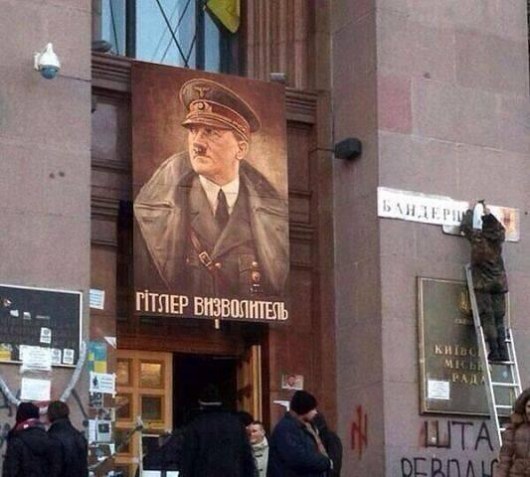 .
.
Of course, symbols like the Celtic Cross are also widely used in Ukraine by nationalists. In fact, along with the flag of Ukraine, the Celtic Cross was even raised on top of certain buildings captured by protestors in Kyiv in the winter of 2013. Naturally, we don’t view the Celtic Cross as ours (and indeed, it is even called the “Celt” in Ukrainian)— nor as a symbol of Nazism. For us, this is simply a symbol of European unity.
Perhaps another reason for this view is our sympathy with so-called “Nazi collaborator” Stepan Bandera. Of course, it wouldn’t matter to us if he was a Nazi-collaborator, but it is strange for a Nazi-collaborator to sit in a German concentration camp during the war, as well as to have his immediate family members executed by the Nazis. For us, Bandera is a symbol of someone who fought for an independent Ukraine: nothing more, nothing less.
Besides Bandera, there is SS Galicia — a Ukrainian nationalist movement during World War Two that was actually allied with Germany (not only allied in Soviet propaganda, as in the case of Bandera). Of course, we sympathize with them as well — but because they also fought for the rights of Ukrainians. In this sense, SS Galicia is much more like similar movements in the Baltics or Croatia directly allied with Nazi Germany than Stepan Bandera’s movement that fought against the Nazis as much as against the USSR. There are numerous nationalist folk songs about both the movement of Bandera and SS Galicia.
What might surprise many is that the Ukrainians who fought in the Red Army are also viewed as heroes by the vast majority of Ukrainian nationalists. We differentiate the Red Army, where most people were forced to fight, from the secret police like the NKVD, where people went by their own will. They, of course, are absolute enemies. The grandfathers of many nationalists fought in the Red Army, and no one views it as something they are afraid to mention. The majority of veterans of these armies now shake hands and are all happy that their dream of an independent Ukraine finally came true. The fact that three separate armies existed of the same people is a small example of a large tragedy that took place during WWII — a war between brothers.
To summarize, while Ukrainians are by far not “anti-fascists.” the view held by most Ukrainian nationalists is that Germany sadly lost the war because of its own ethnic chauvinism. Had it recognized the Ukrainian state in 1941, it would have obtained an enormous amount of resources and manpower that could have shifted the balance of the war. But it didn’t and actually threw the leaders of that state in jail. This ultimately turned most locals against them. Ukrainian nationalists are not Nazis or neo-Nazis.
Below: Examples of variations of the Idea of the Nation symbol used today
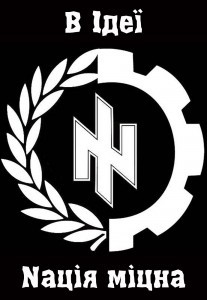
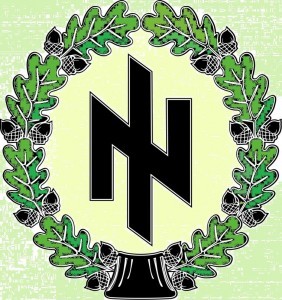
Below: Idea of Nation symbol on Maidan, mistakenly called a Wolfsangel. Note numerous Orthodox icons in the background.
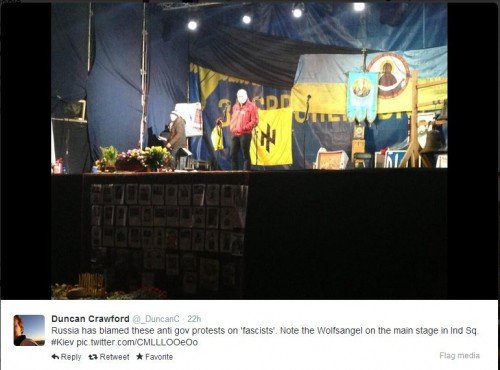
Below: Same symbol on protesters.
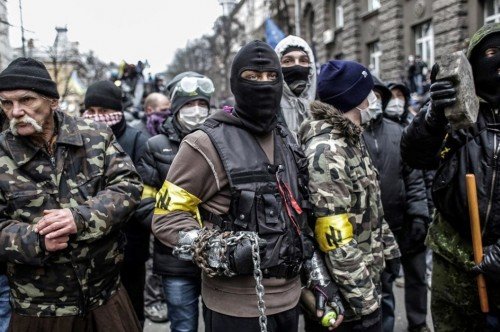
Myth 4: Divided Ukraine
This myth states that there is some sort of deep and eternal divide in Ukraine — a divide so large that it has caused “civil war.” This divide is between Western and Eastern Ukraine and the fact that Western Ukraine is “Ukrainian,” whereas eastern Ukraine is “Russian”.
In reality, every single piece of land in modern Ukraine is ethnically Ukrainian and belongs to Ukraine. It is land where the Ukrainian nation historically formed and land where one, united national consciousness existed that sometimes even transcended borders.
I will not get into history, except to say that after losing statehood in the 13th century to the Mongols, Ukrainians did not regain it again until the 20th century.
(For a good account of the basic history, I recommend Emile Durand’s Countercurrents article, “White Nationalist Delusions about Russia,” because it differentiates between Kyivian Rus [which was an early Ukrainian and perhaps Belarusian state that later helped in forming Russia] and the Grand Duchy of Moscow, which was an early Russian state. They were two separate political entities.)
When Ukraine was invaded by the Mongols in the 13th century, different principalities fell at different times, and a united Ukraine, incorporating both the Western and eastern parts that were ruled by Kyiv prior to this invasion did not come into existence again until the early 20th century.
The Mongol invasion was the beginning of a long occupation by foreign powers. Yet, despite this, both in Eastern and Western Ukraine, Ukrainian political entities existed on every piece of land that is currently Ukraine. Whether in the form of autonomy within a greater empire (such as inside Poland or in the Rzeczpospolita) in Western Ukraine, or in terms of briefly independent states and/or autonomy in Central and Eastern Ukraine, there is an array of evidence that shows the rulers of these states/autonomies viewed themselves as rulers of a particular people, as did ordinary citizens. They spoke the same language, had the same heroes, professed the same religion, had the same traditional clothes and had the same traditions. Again, as mentioned earlier: Ukrainians in history are much like the Kurds today.
As mentioned above, the predecessors to modern Ukraine can be viewed as three separate states: the Ukrainian People’s Republic of 1918 (covering some of modern-day Western Ukraine, modern-day Central Ukraine, modern-day Eastern Ukraine, as well as some lands currently located inside Russia), the Western Ukrainian People’s Republic (covering most of modern-day Western Ukraine) and Carpathian Ukraine (covering the rest of modern-day Western Ukraine).
It is quite clear that the Ukrainian People’s Republic, even in 1918, was as pro-Ukrainian as any political entity that ever existed in Ukrainian history. All of Eastern Ukraine today, as well as some lands currently located in Russia, were in this state, and inside the state they clearly had a Ukrainian identity. After centuries of being in the Russian Empire, it was clear that this region of modern day Ukraine never viewed itself as even anything other than Ukrainian.
The only reason the Ukrainian People’s Republic and the Western Ukrainian People’s Republic did not re-unite was due to the fact that the Western Ukrainian People’s Republic was so short-lived and did not obtain the international recognition that the Ukrainian People’s Republic did. Yet, after the Western Ukrainian People’s Republic fell, the security units of that state immediately transferred into the Ukrainian People’s Republic and, alongside the Ukrainian units of the army of the former Russian Empire, formed one national army. Without any conflicts whatsoever.
Again, this is something incredible: men from completely different empires, who lived in different countries for hundreds of years, immediately understood each other as one and formed one army. The Kurds of Europe.
Incidentally, one further interesting fact is that Eastern Ukraine at the time was originally staunchly anti-Moscow — it proposed getting closer to Poland as being the best idea for an independent Ukraine, while Western Ukraine was originally staunchly anti-Poland, and wanted to get closer to Moscow.
So, what exactly happened?
Why was Eastern Ukraine the heart of Ukrainian nationalism then, and why is it not now? Why was it the headquarters for Ukrainian intellectuals deciding how to liberate Western Ukraine and create — finally — a united Ukraine, and something quite different now? How did it go from being the heart of Ukrainian identity in the 1920s to the heart of anti-Ukrainian separatists in 2014?
The politically incorrect reality is that the division of modern Ukraine is largely a result of the Holodomor 1932–1933 famine. This genocide specifically targeted Ukrainians and Ukrainian cultural presence in the part of Ukraine that was then part of the Soviet Union: Eastern Ukraine, as well as areas where mostly Ukrainians lived that are now part of Russia, like the Kuban region. There is no division between Ukrainians. There is a division between Ukrainians and the descendants of those whom the Soviet government moved to Eastern Ukraine to replace the murdered Ukrainians. We are all well aware that the famine itself was not committed by Russians. Yet, the population of the region was nevertheless largely changed from Ukrainians to Russians.
Yes, there are other differences: one side of Ukraine was historically more influenced by Poland, and the other Russia; on one side, one finds more Catholicism than the other. But this is very minor and these differences never stopped Ukrainians in history from Eastern and Western Ukraine as always viewing each other as the same people. Furthermore, such differences exist in all countries. The division of Ukraine today is a direct result of the Holodomor and the mass political repression against the Ukrainian identity that followed, changing Eastern Ukraine from a center of Ukrainian nationalism to an exhausted region without an identity.
Out of the key modern Ukrainian nationalist thinkers through history, the majority are not from Western Ukraine (as Russia Today or Alexander Dugin might claim), but eastern Ukraine: everyone from Dmytro Dontsov (the greatest Ukrainian traditionalist thinker and theoretician of integral nationalism, he actively worked with Stepan Bandera), to Mykola Mikhnovsky, to Mykola Stsiborsky, to Taras Shevchenko and beyond… . All of these intellectuals had a vision of one, united Ukraine and had no sympathy for Moscow, which they viewed as an oppressor.
The referendum on independence, in which every modern region of Ukraine voted on whether it wanted to be part of a future, independent Ukraine, was conducted in 1991. The results can be seen below. Needless to say, the overwhelming majority of the population in every part of the country voted to be part of an independent Ukraine. In general, the support for Ukrainian unity and independence was supported by around 95% of Western Ukraine and 90% of eastern Ukraine. It is also worth noting that the opposition against the vote was strongest in areas with the highest numbers of ethnic Russians. Indeed, only in Crimea, which is the only region of Ukraine where the majority of the population is ethnically Russian (largely due to the Soviet Union) were the results even close, with 56% voting for, 41% voting against and the rest abstaining or not voting correctly.

Percentages voting ‘yes’ at the 1991 referendum

Percentages voting ‘no’ in the 1991 referendum)
Ukraine is a completely homogenous country. In 2001, ethnic Ukrainians composed almost 80% of the country. They are a strong majority not only in all of Western Ukraine, but in Eastern Ukraine too. Thus, certain news reports calling eastern Ukraine “Russian inhabited” are completely false. Ethnic Ukrainians are the vast majority of the population, although there does exist a vocal Russian minority. Russians are approximately 17% of the population of Ukraine, and around 15% to 30% of eastern Ukraine, depending on the region, with ethnic Ukrainians composing the rest.
Even despite the Holodomor, Eastern Ukraine remains staunchly pro-Ukrainian. Although a strange example, I feel it is actually quite telling: those who talk of a divided Ukraine should merely watch matches of the Ukrainian football team in any city of Ukraine and observe how people celebrate after a victory. Regardless of the city, the support is very strong anywhere it plays. In cases of a truly divided country — such as the old Yugoslavia — I cannot imagine Croatia playing a match in Belgrade and receiving staunch support or fans singing the Serbian anthem in Zagreb. Yet the Ukrainian national team can play anywhere in eastern Ukraine and receive incredible support, as it did during Euro-2012. This is minor, yet telling.
Even today, and despite all of this history, there hardly exists a divide between Eastern and Western Ukraine. Eastern Ukraine today largely speaks Russian. This is a result of the Holodomor and the staunch Russification policies of the USSR that followed. Yet, the overwhelming majority of eastern Ukraine view their native language as Ukrainian. Everyone in eastern Ukraine speaks Ukrainian fluently, and it is only a generation before the majority will speak Ukrainian in day-to-day life. There is currently a rebirth and reawakening of Ukrainian identity well underway in eastern Ukraine, as the vast majority of the population take back what is rightfully theirs. This will be and is undoubtedly something that the aggressive minority of the population — largely the ancestors of those brought to Ukraine after the Holodomor — dislikes.
To summarize, Ukrainians are, indeed, a real nationality with a long history. Although Ukrainians are very far from being anti-fascists, the average Ukrainian sees himself as a Ukrainian nationalist, not a Nazi. There is no division of Ukrainians based on geography or religion. There is a division between those inside Ukraine who recognize Ukraine and those who hate Ukraine, similar in the West to anti-Whites.







Comments are closed.